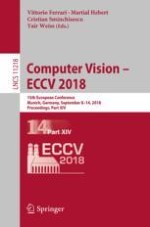2018 | OriginalPaper | Chapter
DeepVS: A Deep Learning Based Video Saliency Prediction Approach
Authors : Lai Jiang, Mai Xu, Tie Liu, Minglang Qiao, Zulin Wang
Published in: Computer Vision – ECCV 2018
Publisher: Springer International Publishing
Activate our intelligent search to find suitable subject content or patents.
Select sections of text to find matching patents with Artificial Intelligence. powered by
Select sections of text to find additional relevant content using AI-assisted search. powered by
